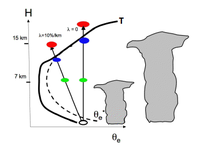Entrainment (meteorology)
Entrainment (eng. Air inclusion) is a phenomenon of the atmosphere and describes the trapping of the air mass of a non-turbulent flow by a turbulent flow. The term is typically used for trapping an air mass of abnormal humidity, such as B. in cloud physics or in the case of the tropical cyclone the trapping of dry air.
Detrainment is the opposite effect when air from a convective cloud, usually at the top of the cloud, flows into the surrounding air mass.
background

Entrainment describes the mixing of ambient air into an existing air flow or cloud. The mixed in ambient air becomes part of the air flow or cloud during the entrainment process. In cloud physics, the entrainment coefficient is one of the decisive variables of the remaining uncertainty of climate models .
Homogeneous mixing is a model used to describe the entrainment process. It is assumed that the timescale for the mixing of dry air into the cloud is significantly shorter than the timescale for the drop dissolution. This would mix the dry, unsaturated ambient air into the cloud over a large area before it completely dissolves cloud droplets. In this model, entrainment manifests itself as a decrease in the water mass of the drops without reducing their number.
An alternative model of entrainment is inhomogeneous mixing . The case is assumed that the time scale of the drop dissolution is significantly shorter than the time scale of the mixing in of dry air. Here, cloud droplets are completely dissolved in the mixing zone, which reduces the total number of droplets in the cloud.
The main difference between the two models is their influence on the cloud droplet size distribution. Homogeneous mixing changes the shape of the distribution because the saturation vapor pressure is different for large and small droplets. In the case of entrainment via homogeneous mixing, the cloud droplet size distribution becomes narrower, while in the case of inhomogeneous mixing it remains the same shape.
Entrainment rate
Cumulus clouds have a significant influence on energy and moisture transport, and thus also on precipitation and the climate. Cumulus clouds must be parameterized in large-scale models. The entrainment rate is an important parameter. Henry Stommel pioneered the study of the rate of entrainment in cumulus clouds.
literature
- C. Lu, S. Niu, Y. Liu, A. Vogelmann: Empirical relationship between entrainment rate and microphysics in cumulus clouds. In: Geophys. Res. Lett. Volume 40, 2013, pp. 2333-2338.
- C. Lu, Y. Liu, S. Niu: A method for distinguishing and linking turbulent entrainment mixing and collision-coalescence in stratocumulus clouds. In: Chin. Sci. Bull. Volume 58, 2013, pp. 545-551.
- C. Lu, Y. Liu, S. Niu, A. Vogelmann: Lateral entrainment rate in shallow cumuli: Dependence on dry air sources and probability density functions. In: Geophys. Res. Lett. Volume 39, 2012, p. L20812.
- C. Lu, Y. Liu, S. Yum, S. Niu, S. Endo: A new approach for estimating entrainment rate in cumulus clouds. In: Geophys. Res. Lett. Volume 39, 2012, p. L04802.
- C. Lu, Y. Liu, S. Niu: Entrainment mixing parameterization in shallow cumuli and effects of secondary mixing events. In: Chinese Sci. Bull. Volume 59, No. 9, 2014, pp. 896-903.
- C. Lu, Y. Liu, S. Niu: Examination of turbulent entrainment-mixing mechanisms using a combined approach. In: J. Geophys. Res. Volume 116, 2011, D20207.
- F. Burnet, JL Brenguier: Observational Study of the Entrainment-Mixing Process in Warm Convective Clouds. In: J. Atmos. Sci. Volume 64, 2007, pp. 1995-2011.
- F. Chosson, JL Brenguier, L. Schüller: Entrainment-Mixing and Radiative Transfer Simulation in Boundary Layer Clouds. In: J. Atmos. Sci. Volume 64, 2007, pp. 2670-2682.
- AA Hill, G. Feingold, H. Jiang: The Influence of Entrainment and Mixing Assumption on Aerosol – Cloud Interactions in Marine Stratocumulus. In: J. Atmos. Sci. Volume 66, 2009, pp. 1450-1464.
- E. Hicks, C. Pontikis, A. Rigaud: Entrainment and Mixing Processes as Related to Droplet Growth in Warm Midlatitude and Tropical Clouds. In: J. Atmos. Sci. Volume 47, 1990, pp. 1589-1618.
- CA Pontikis, EM Hicks: Droplet Activation as Related to Entrainment and Mixing in Warm Tropical Maritime Clouds. In: J. Atmos. Sci. Volume 50, 1993, pp. 1888-1896.
- BA Baker: Turbulent Entrainment and Mixing in Clouds: A New Observational Approach. In: J. Atmos. Sci. Volume 49, 1992, pp. 387-404.
- IR Paluch: The Entrainment Mechanism in Colorado Cumuli. In: J. Atmos. Sci. Volume 36, 1979, pp. 2467-2478.
- M. Baker, J. Latham: The Evolution of Droplet Spectra and the Rate of Production of Embryonic Raindrops in Small Cumulus Clouds. In: J. Atmos. Sci. Volume 36, 1979, pp. 1612-1615.
- MB Baker, RG Corbin, J. Latham: The influence of entrainment on the evolution of cloud droplet spectra: I. A model of inhomogeneous mixing. In: Quarterly Journal of the Royal Meteorological Society. Volume 106, 1980, pp. 581-598.
Individual evidence
- ↑ CG Knight, SHE Knight, N. Massey, T. Aina, C. Christensen et al .: Association of parameters, software, and hardware variation with large-scale behavior across 57,000 climate models . In: Proc. Natl. Acad. Sci. UNITED STATES. Volume 104, 2007, pp. 12259-12264.
- ↑ a b c P. R. Jonas: Turbulence and cloud microphysics. In: Atmospheric Research. Volume 40, No. 2-4, 1996, pp. 283-306, doi: 10.1016 / 0169-8095 (95) 00035-6 .
- ^ A b C. Lu, Y. Liu, S. Niu, S. Krueger, T. Wagner: Exploring parameterization for turbulent entrainment-mixing processes in clouds . In: J. Geophys. Res. Volume 118, 2013, pp. 185-194.
- ^ H. Stommel: Entrainment of air into a cumulus cloud. In: Journal of Atmospheric Sciences. Volume 4, 1947, pp. 91-94.

